Much of this article relates to the final versions of Middle-earth's history, and as such may contain discrepancies with The Silmarillion. See LOTR:Canon for a discussion. This subject's portrayal in earlier or alternative versions is discussed in the Earlier versions of the legendarium section.
Sauron (Q.: IPA [ˈsaʊron] or [ˈθaʊron]); "The Abhorred"), or the eponymous Lord of the Rings, was a fallen Maia, creator of the One Ring, a gifted student of Vala Aulë the Smith and lieutenant of Melkor (Morgoth). After his master's defeat by the Valar, Sauron became the second Dark Lord and sought to conquer Middle-earth by creating the Rings of Power.
At the end of the Second Age, he was defeated in the War of the Last Alliance of Elves and Men united under kings Gil-galad and Elendil. In the final battle, Isildur managed to cut the One Ring from Sauron's finger, dismantling the Dark Lord's corporeal form and power. After centuries lying dormant, rebuilding his strength, Sauron returned to power late in the Third Age, but was permanently crippled in the War of the Ring after destruction of the One Ring in the fires of Mount Doom by a hobbit named Frodo Baggins.
Sauron was also called Gorthaur the Cruel by the Elves of Beleriand in the First Age.
Quick Answers

Who is Sauron?

Who did Sauron disguise himself as?

Why is Sauron evil?

Is Sauron the same race as Gandalf?

Is Sauron a human or elf?

Biography
Origin
Long before the First Age, Sauron's name was originally Mairon, meaning "the admirable". Then he was the mightiest Maia of the Vala Aulë the Smith, and learned much from Aulë in the ways of smithing and handiwork, becoming a great craftsman, and "mighty in the lore of" Aulë's people.[2] He was among the most powerful Maiar.
During this time, Mairon was as Eru had created him: good and uncorrupted. His greatest virtue was his love of order and perfection—dislike of anything wasteful. However, this would also prove to be the cause of his downfall, because Mairon saw in the Dark Lord Morgoth the will and power that would help him achieve his own goals and desires faster than if he pursued them alone. However, while Morgoth wanted to either control or destroy Middle-earth itself, Mairon's desire was to dominate the minds and wills of its creatures. Though he allied himself with Morgoth, in truth, Sauron did not seek to serve, only to command (which would prove useful in understanding the mind of Saruman). In testimony to his cunning, Sauron benefited from his former services: presenting himself as a minister of the Valar to the Elves, and later as Morgoth's prophet to the Numenoreans (when other means would not do).
After allying himself with Morgoth, Mairon maintained his appearance of being faithful to the Valar, but secretly fed Morgoth information about their dealings. It was only when Morgoth established his strongholds in Middle-earth that Mairon left Valinor and openly declared his allegiance, thence remaining a recognized foe of the Valar and the Free Peoples of Middle-earth.
The Sindar Elves in Beleriand called him Gorthaur, meaning "dread abomination"[3],while others of the Eldar named him Sauron, meaning "the abhorred" or "the abominable" (a mockery of his original name).
First Age
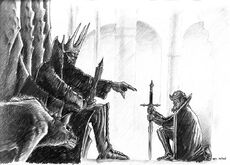
Morgoth and Sauron, by Eric Faure-Brac
In the First Age, the Ñoldor Elves left the Blessed Realm of Valinor in the Utter West (against the counsel of the Valar) in order to wage war on Morgoth, who had stolen the Silmarils of Fëanor, enchanted gems that glowed with light from the now-destroyed Trees of Valinor. In that war, Sauron was counted as the "greatest of [Morgoth's] servants that have names". His only equal in rank was Gothmog, the High Captain of Angband, and was soon feared as a lord of terrible phantoms and dreadful beasts--a shape-shifter, sorcerer, and cunning servant of his master.
Before Melkor's captivity, Sauron commanded the fortress of Angband and served as Melkor's lieutenant. At the beginning of the War of Powers, the Valar forces leveled Angband with little difficulty, though it is not know for certain if Sauron was present when the fortress was attacked. When Utumno was sacked and Melkor captured, Sauron was nowhere to be found, and in their haste to both capture Melkor and remove him from Middle-earth, the Valar paid little heed to Melkor's most terrible servants.[4]
When Melkor left Angband much later to corrupt the newly awakened Atani (Men), Sauron directed the war against the Elves.[5] He conquered the Elvish isle of Tol Sirion, so that it became known as Tol-in-Gaurhoth, the Isle of Werewolves.[6] He was the Lord of the Werewolves there, and Draugluin was the sire of the Werewolves. Sauron's herald was the vampire Thuringwethil.

Sauron and Finrod, King of Nargothrond, duel in songs of power
After Dagor Bragollach, Sauron's hunters brought Gorlim and interrogated him about Barahir's (father of Beren) location. Gorlim refused to tell them anything, even under torture, until Sauron himself came forth and bartered with the man. Gorlim asked for his wife Eilinel, whom he thought captured. Thus, Sauron agreed and Gorlim yielded the information. However, Sauron revealed that Eilinel was dead, and he put Gorlim to death afterward. During the Quest for the Silmaril, Beren and Finrod King of Nargothrond were captured by Sauron, who defeated Finrod in a duel with songs of power. He stripped them of their Orc disguises and cast them into the dark pits where werewolves devoured their companions. When a werewolf came to attack Beren, Finrod wrestled with and killed it, but died soon after of his injuries.
Soon afterward, Lúthien and Huan the wolfhound arrived at the bridge of Tol-in-Gaurhoth. Sauron sent wolves to capture Lúthien, but all were slain by Huan. One of them was Draugluin, but he fled and told his master that Huan was there. Therefore, Sauron took the form of a werewolf and leaped to attack Lúthien, only to be intercepted and subdued by Huan. He yielded the tower to Lúthien and escaped in the form of a "vampire".[7]
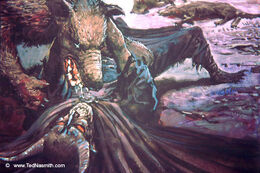
Huan subdues Sauron (by Ted Nasmith)
After his defeat by Lúthien, Sauron played little part in the events of the First Age (possibly hiding from Morgoth's scorn or wrath). After his former master was defeated and taken to Valinor in chains, Sauron seemed to repent and plead Eönwë and the victorious Host of the West for mercy, although he may have only been daunted by their triumph. At the same time, Sauron was unwilling to return to the Utter West for judgment out of pride, and instead fled and hid somewhere in Middle-earth.[8]
Second Age
Forging of the One Ring
This is the Master-ring, the One Ring to rule them all. This is the One Ring that he lost many ages ago, to the great weakening of his power. He greatly desires it – but he must not get it.
—Gandalf, The Lord of the Rings, "The Shadow of the Past" pg.48(Bottom)
After remaining hidden and dormant for five hundred years, Sauron began revealing himself once more, and by SA 1000 he gathered his power and established himself in the land of Mordor in eastern Middle-earth and began building the dreaded Barad-dûr near Mount Doom. Sauron soon began raising massive armies of Orcs, Trolls, and other creatures from the days of Morgoth, as well as corrupting the hearts of Men, chiefly the Easterlings and Southrons (the Haradrim) with delusions of power and wealth. It may be noted that at first he was not wholly evil, rather intending to rebuild Middle-Earth from the destruction caused at the battle at the end of the First Age, but slowly he was corrupted by lure of power and the 'bonds' Melkor placed upon him, causing him to revert to his old devices so that by the late Second Age and Third Age.
Although Sauron knew that men were easier to sway, he sought to bring the Elves into his service, as they were far more powerful. By about SA 1500, Sauron put on a fair visage and called himself Annatar, the "Lord of Gifts". He befriended the Elf smiths of Eregion, including Celebrimbor (greatest of craftsmen, as he was descended from Fëanor), and counseled them in arts and magic. Not all the Elves trusted him, particularly Lady Galadriel, Elrond, and Gil-galad, High King of the Ñoldor.

Sauron, as Annatar, aided the Elves of Eregion in the forging of the Rings of Power
To the Elves who listened, Sauron gave knowledge and encouragement in forging the Rings of Power, while he forged the One Ring in secret, to rule the Elvish rings. Upon that ring Sauron wrote in Tengwar the Black Speech inscription, Ash nazg durbatulûk, ash nazg gimbatul, ash nazg thrakatulûk, agh burzum-ishi krimpatul. This translates as: One Ring to Rule Them All, One Ring to Find Them, One Ring to Bring Them All, and in the Darkness Bind Them.
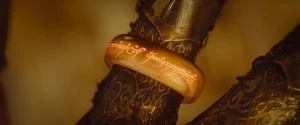
The One Ring worn by Sauron
However, as soon as Sauron put on the Ring the Elves sensed his treachery, and removed their rings and hid them. Enraged, Sauron came against them in open war and demanded that all Rings of Power be given to him. The Elves managed to hide the three greatest of the Rings from him, but the other sixteen Rings of Power were either captured by Sauron, destroyed, or lost. To the Dwarves he had given Seven, but to Men he had given Nine, knowing that they would be the easiest to corrupt. The Dwarf Lords who received the Rings proved to be very resistant to their power, and neither "faded" nor became enslaved to Sauron's will. The Rings, however, created in them an insatiable lust for gold, which ultimately caused a great deal of grief for the Dwarves.
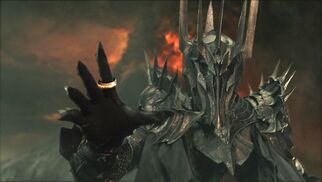
Sauron's appearance in Peter Jackson's The Lord of the Rings film trilogy
As Sauron predicted, the nine Men were all corrupted by their Rings and became the Nazgûl, Sauron's deadliest and cruelest servants. Had the Elves not recognized Sauron's treachery and forsaken the power of their rings, the results would have been catastrophic for the Free Peoples of Middle-earth. It seems that most if not all of the native Men of Middle-earth succumbed to the power of the Ring once the Nazgûl were created, and if the Elves been captured in this fashion, they would have become the slaves of Sauron. Thus Celebrimbor's resistance was of immense importance in the history of Middle-earth.
In this era, during which he marshaled and commanded great armies, Sauron became known as the Dark Lord of Mordor, and his fortress of Barad-dûr was completed. He was very powerful even without controlling the Elves, and conquered nearly all of Middle-earth during the War of the Elves and Sauron. However, the armies of the king of Númenór, Tar-Minastir, were finally able to defeat him during the last battle near Gwathló or the Greyflood in SA 1700. Defeated but not wholly vanquished, Sauron retreated back to Mordor and began re-building his strength over the many centuries.
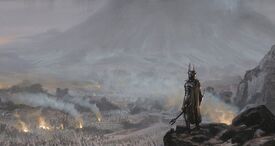
Sauron overlooking his Orc army at Gorgoroth
Towards the end of the Second Age, Sauron was once again powerful enough to raise again large armies to attempt to rule Middle-earth. By this time, he assumed the titles of "Lord of the Earth" and "King of Men", which offended the Númenóreans; the powerful Men descended from those who had fought against Melkor in the War of Wrath. Some were the descendants, through Elros, of Beren and Lúthien.
Life in Númenor

These Men lived on the island of Númenor in the sea between Middle-earth and Valinor. The Númenóreans, who were then proud, came to Middle-earth with astounding force of arms. King Ar-Pharazôn, who desired no less than the kingship of Middle-earth, marched his troops all the way to Mordor without a single battle, and demanded that Sauron abase himself before the King. Sauron could see clearly that even the most powerful of his servants could not stand against the Númenóreans, and so came from Barad-dûr without any offer of battle. He assumed a fair form and flattered Ar-Pharazôn, but the King demanded that Sauron come back to Númenor as a hostage. Sauron feigned unhappiness at this development but was secretly delighted, for this presented him with an opportunity to destroy the Númenóreans from within. After only a few short years in Númenor he grew from captive to the King's most trusted adviser, and nearly all the King's court fawned upon him. Drawing on their fear of death, he converted many Númenóreans to the worship of Morgoth, saying that Morgoth had the power to save them from mortality. As his power and influence reached its peak, he raised a great Temple in which he performed human sacrifices to Morgoth. Finally, he convinced Ar-Pharazôn to rebel against the Valar and attack Valinor itself and claim it for himself.
But here, Sauron's cunning overreached itself, for Eru then directly intervened—Númenor was drowned under the sea, and the great navy of Númenor was destroyed and the army that reached Aman was buried under mountains of falling rock and imprisoned in the Caves of the Forgotten. The world was bent, so that thereafter, only Elven-Ships could sail into the Utter West. Sauron's body was destroyed, but his spirit was not diminished, and he fled back to Mordor bearing the Ring, where he slowly rebuilt a new body and his strength during the time known as the Dark Years. From this point on, he lost the ability to assume a fair shape, and ruled now through terror and force. A few faithful Númenóreans led by Elendil were saved from the flood, and they founded two Realms in Exile, Arnor and Gondor, in Middle-earth.
Loss of the Ring
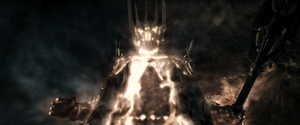
Sauron's destruction in battle by Isildur
After learning that Elendil, whom he had especially hated, had survived and was ordering a realm on his borders, Sauron, after a while, made war with them. He struck too soon, however, and had not restored most of his strength, whereas the Elven-king, Gil-galad had increased his power on Middle-earth in his absence. Therefore, when Gil-Galad allied with Elendil to create the Last Alliance and together fought Sauron, they finally defeated his armies at the Battle of Dagorlad, and laid siege to Barad-dûr for seven years. Finally, Sauron himself came forth and duelled with both Elendil and Gil-galad, slaying them both single-handedly; however, he himself was slain himself in the process. Then Isildur, son of Elendil, took up his father's broken sword, Narsil, and used it to cut the One Ring from Sauron's finger. While Sauron's physical body was destroyed, his spirit endured and fled. But his campaign to defeat the free peoples had seemingly failed, with his greatest weapon having been taken from him.
But while Isildur had taken the Ring, he could not bring himself to destroy it in the fires of Mount Doom where it was forged, but kept it for himself. He was eventually betrayed by it a few years later, and slain by Orcs at Gladden Fields. The Ring fell into the river Anduin, and was lost for centuries before being found by the two Stoorish friends and relatives, Sméagol and Déagol. Shortly afterwards Sméagol murdered Déagol for possession of the Ring.
Third Age
Despite his defeat, Sauron was not vanquished permanently. Though greatly weakened, and in non-corporeal form, he still existed, due to pouring most of his native power, strength, and will into the One Ring. Thus, as long as it existed, he could never be truly defeated, and during the first thousand years of the Third Age, he lay in hiding, slowly recovering his strength until he was once again able to create a body for himself.
The Necromancer of Dol Guldur
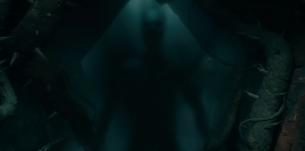
Sauron's appearance as the "Necromancer", as shown in The Hobbit: An Unexpected Journey
In the year TA 1000, Sauron at last began to rise again, taking the stronghold of Dol Guldur, the Hill of Sorcery, in southern Mirkwood in TA 1050. There, he was disguised as a dark sorcerer known as "the Necromancer", and the Elves did not realize at first that he was actually Sauron returned.
Around this time, the Valar sent the five Wizards, or Istari, including Gandalf the Grey, who later became Gandalf the White, to oppose Sauron and rally the free peoples of Middle-earth against him.
While Sauron continued to gather his strength, the Ringwraiths reappeared in the year TA 1300, and began steadily assaulting the Númenórean kingdoms in exile, ultimately destroying the North Kingdom of Arnor and gravely weakening the South Kingdom of Gondor.
Suspecting that Sauron had returned and was guiding the Nazgûl, the wizard Gandalf infiltrated the fortress in TA 2063 to confirm his theory, but Sauron fled into the east to conceal his identity. This marked the beginning of the Watchful Peace, which ended with Sauron's return to Dol Guldur in TA 2460. During the same year, the One Ring was finally discovered by the stoor Sméagol and his friend Déagol.
Gandalf the Grey made a second intrusion into Dol Guldur in TA 2850, and finally discovered that the Necromancer was indeed Sauron. Eventually, the White Council put forth their might and drove Sauron from Dol Guldur permanently in TA 2941. Without the Ring in his possession and facing the power of the three Elven rings, Sauron could draw on only the smallest fraction of his strength, so that his enemies were able to drive him from Dol Guldur with relative ease. However, the Dark Lord, having had ample time to prepare, abandoned Dol Guldur willingly, and returned to Mordor, where he openly declared himself in TA 2951, and began preparations for his final war against the free peoples of Middle-earth.

The Ringwraiths in The Fellowship of the Ring
War of the Ring
Sauron bred immense armies of Orcs and allied with and enslaved Men from the east and south. He gathered his most terrifying servants, the Nazgûl (Ulairi in Quenya), or Ringwraiths, each wearing one of the nine rings designed for mortal men. He adopted the symbol of a lidless eye, and as he exerted his will over Middle-earth, the Eye of Sauron became a symbol of power and fear.
After the creature Gollum, originally the stoor-hobbit Sméagol who had originally found the ring, was captured, Sauron had him tortured and learned that he once had a magic ring, and, from him, he heard the words Shire and Baggins. He deduced that Gollum's ring was the One Ring, and sent his servants, the dreaded Nazgûl, to find Shire and search for Baggins, so that the One Ring might be found and returned to him.
Meanwhile, Sauron lured Saruman the White, one of the Istari, into his service, and used him to try to destroy Rohan, one of the major obstacles to Sauron's conquest of Gondor and the remaining Elves. Saruman failed however, and Sauron lost one of his most powerful vassals as well as Saruman's massive Uruk-hai army.
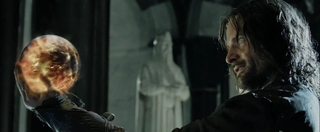
Aragorn reveals himself to Sauron through the Palantír
Shortly after Saruman's defeat, Peregrin Took looked into the Palantír that the wizard had possessed and accidentally communicated with Sauron, who believed that his treacherous servant had captured either the Halflings bearing the Ring, or some who might know of it. But shortly thereafter Aragorn took the Palantir and revealed himself to Sauron, and seeing Aragorn, the Dark Lord concluded that Saruman had fallen and that the heir of Isildur possessed the One Ring. Fearing that his enemies would use the Ring against him, Sauron sped up his plans and attacked the city of Minas Tirith in Gondor sooner than he had planned, seeking to raze the city and crush the last human resistance to his rule before his enemies could fortify it, and to prevent Men uniting under one king.
Fortunately, due to the combined efforts of Gondor, Rohan, and the Dúnedain of Arnor, Sauron's army was defeated. Despite still possessing more than enough armies to destroy Minas Tirith and enough military strength to easily conquer Middle-earth once Gondor fell, doubt began to grow in Sauron. As such, he watched and waited, hoping for a period of strife between Aragorn and other potential Ringlords in which he could move out and take the Ring for himself.
Downfall
Despite their successful repulsion of Sauron's armies at Minas Tirith, Gandalf and Aragorn knew that the bulk of Sauron's forces remained in Mordor, readying themselves for another, deadlier strike against the city. Filled as Mordor was with Sauron's troops, Frodo stood almost no chance of reaching Mount Doom undetected. In light of the situation, Aragorn called for a council consisting of the major commanders of all the forces present in Minas Tirith, and appointed Gandalf to be their commander until the crisis had passed. Gandalf made it clear to all those present that, despite their great victory, they ultimately could not hope to defeat Sauron's armies by force. Therefore, they had two options available. They could station their remaining force, considerably greater than it had been before the battle due to the reinforcements from Rohan and southern Gondor, at Minas Tirith and hope to endure Sauron's next attack. Or, they could take a force to the Black Gate and attempt to challenge Sauron directly. This force, as Gandalf suggested, would only need to be great enough to challenge battle, and the rest of their forces could remain behind to garrison Minas Tirith. This option, though suicidal for those involved, would serve to distract Sauron from gazing into his own land, through which the Ring Bearer would be traveling. Furthermore, Gandalf theorized that, once Sauron learned that a force too small to pose any real threat to him was on its way to the Black Gate to directly assault Mordor, he would likely believe that the leader of the attacking force would have the One Ring in their possession. Sauron would assume that the Ring itself would influence its wielder, who, in his pride and over-confidence in his newfound power, might be foolish enough to challenge Sauron's might with a force too small to assault Mordor in earnest.[9]
Their plot worked, as Sauron marshalled most of his remaining forces and marched them towards Udûn to crush the Men of the West and regain his prize. This action left the Plains of Gorgoroth largely unguarded, allowing Frodo and Sam to reach Mount Doom with far less difficulty than otherwise. However, once Frodo reached the Crack of Doom, he finally succumbed to the power of the Ring, and put it on. Immediately, Sauron became aware of the halfling, and turning his gaze towards the mountain. He frantically sent the Ringwraiths to retrieve the Ring, but was too late, as Gollum, after taking the Ring from Frodo, slipped and fell to his death into the Cracks of Doom. The Ring was unmade. The earth shook as a great shock wave rippled across Mordor, and the foundations of Barad-dûr were finally destroyed, causing the great fortress to fall into ruin once and for all. Mount Doom was completely destroyed in a cataclysmic eruption that consumed the eight remaining Nazgul.[10]
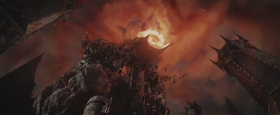
Barad-dûr's downfall
With his source of power gone, Sauron was utterly defeated and his armies were destroyed or scattered, bereft of the driving will behind their conquest. With the Ring's destruction, Sauron was permanently robbed of his physical form, reducing him to a malevolent spirit that hovered above Mordor as a "huge shape of shadow, impenetrable, lightning-crowned, ...terrible but impotent," only to be blown away by a great wind.[11]
With the destruction of the Ring, the vast majority of Sauron's being and his power was forever lost. With that, Sauron's power was forever crippled, and the threat of his dominion was forever removed.
"If it [the Ring] is destroyed, then he will fall, and his fall will be so low that none can foresee his arising ever again. For he will lose the best part of the strength that was native to him in his beginning, and all that was made or begun with that power will crumble, and he will be maimed for ever, becoming a mere spirit of malice that gnaws itself in the shadows, but cannot again grow or take shape. And so a great evil of this world will be removed."
—The Return of the King, "The Last Debate"
Etymology
Sauron is the Quenya term for "the Abhorred".[3] In Sindarin, it is translated as Gorthaur from gor ("horror, dread") and thaur ("abominable, abhorrent").[12]
Other names
His original name was said to be Mairon ("the Admirable", from maira meaning "admirable, excellent"), a name he used while in Númenor, adding the title "Tar" for "Tar-Mairon" ("King Excellent").[13] The Númenóreans themselves gave him a name Zigúr meaning "Sorcerer" on the Adûnaic. When disguising himself in the Second Age, he called himself Annatar ("Lord of Gifts"; anna = gift and tar = king, lord), Artano ("High-smith"), and Aulendil ("Friend of Aulë").[14]
His name is sometimes seen written as Thauron (Þauron), an earlier pronunciation of Sauron.
Titles
- The Lord of the Rings
- The Enemy
- The Nameless Enemy
- The Deceiver
- The Dark Lord (Post-First Age)
- The Lord of Barad-dûr
- The Lord of Mordor
- The Necromancer (First Age/Third Age)
Earlier names
Thû was Tolkien's earliest name for Sauron, in the original Lay of Leithian. Thu is reintroduced as an alternate name for Sauron in Beren and Luthien (2017).
Tevildo, before that, was the name of the forerunner character to Sauron, a "Prince of Cats" who is a villain told of in the stories of The Book of Lost Tales. In Beren and Lúthien (2017), Tevildo is presented as a separate character from Thu/Sauron, and one of Morgoth's other minions.
Character
Despite being the title character of The Lord of the Rings, Sauron is notable for never directly appearing during the events of the trilogy. Nowhere is any detailed description given of what he looks like, other than in vague terms.
In The Silmarillion, however, Sauron is described as being a shape changer, and took many forms, including that of a serpent, a vampire, and a great wolf. After Morgoth's fall, Sauron appeared in fair form as "Annatar", the Lord of Gifts, and maintained this appearance until the Fall of Númenor, in which he was unable to ever take a fair form ever again. The History of Middle-earth includes a passage vaguely describing how the Númenoreans saw him: "Upon that ship which was cast highest and stood dry upon a hill there was a man, but greater than any even of the race of Numenor in stature...And it seemed to men that Sauron was great; though they feared the light of his eyes. To many he appeared fair, to others terrible; but to some evil."[15]
A few clues are given as to Sauron's appearance as the Dark Lord, after he lost his ability to take a fair form: Tolkien described Sauron in one of his letters as having the form of a man of more than human stature, but not gigantic, and as an image of malice and hatred made visible. He apparently gave off great heat, so much so that Gil-galad was burned to death by his mere touch, and Isildur described Sauron's hand as black, yet burning like fire, suggesting that his entire body was blackened from fire and heat.
Gollum, having apparently once seen Sauron directly, described him as having only four fingers on his black hand, suggesting that Sauron was unable to regenerate the finger from which Isildur took the One Ring, similar to how the wounds Morgoth took from Fingolfin never healed.
In addition to his physical appearance, Sauron also apparently had an aura of incredible malevolence. A passage in The Silmarillion describes him as having a "dreadful presence," and daunting eyes.[7]
Regarding Sauron's personality, Tolkien had this to say from his letters:
In my story Sauron represents as near an approach to the wholly evil will as is possible. He had gone the way of all tyrants: beginning well, at least on the level that while desiring to order all things according to his own wisdom he still at first considered the (economic) well-being of other inhabitants of the Earth. But he went further than human tyrants in pride and the lust for domination, being in origin an immortal (angelic) spirit. Sauron desired to be a God-King, and was held to be this by his servants, by a triple treachery: 1. Because of his admiration of Strength he had become a follower of Morgoth and fell with him down into the depths of evil, becoming his chief agent in Middle-earth. 2. when Morgoth was defeated by the Valar finally he forsook his allegiance; but out of fear only; he did not present himself to the Valar or sue for pardon, and remained in Middle-earth. 3. When he found how greatly his knowledge was admired by all other rational creatures and how easy it was to influence them, his pride became boundless.
—J.R.R. Tolkien[16]
Philosopher Peter J. Kreeft proposes that Sauron is in fact the main character of The Lord of the Rings, inasmuch as he has the largest significance to the work of good and evil in the story, given his shared essence with the Ring; and given the title's referral to him.
Weapons and powers
Sauron was among the mightiest of the Maiar. Originally of Aulë's people, he acquired great "scientific" knowledge of the world's substances and how to use them. He would retain this knowledge throughout his reign as the Dark Lord in Middle-earth, using it to forge the One Ring and construct his fortress of Barad-dûr. Sauron also seemed primarily linked to the use of fire, and as Morgoth's chief lieutenant, his ability to tap into the fires in the Earth was of great value.

Sauron's fair disguise as "Annatar"
Among Sauron's chief powers were deception and disguise: In the First Age Sauron took on many forms. During his battle against Luthien and Huan in The Silmarillion, he took on no less than four separate shapes: his "normal" shape, (some kind of terrible dark sorcerer), a great wolf, a serpent, and finally a vampire "dripping blood from his throat upon the trees" ("Of Beren and Lúthien," The Silmarillion). At the end of the First Age, Sauron took on a fair form to appeal to the Captain of the Hosts of the Valar and ask for pardon. In the Second Age, Sauron took up that fair form again and used it under the alias "Annatar" to deceive the Elves into creating the Rings of Power. The level of deception required to fool the Elves of Eregion must have gone beyond simply taking on a fair form, since Sauron was literally instructing the Elves to make artifacts that, while capable of great good, were ultimately purposed for his own domination and were imbued with power to arrest the natural order of the world, yet the Elves were unaware of who they were dealing with until the eleventh hour, and only narrowly escaped his trap. Centuries later, Sauron was able to deceive the Númenóreans and steer them directly to their own destruction under promises of eternal life. Such destruction is a testament to Sauron's manipulative nature and ability to twist the perceptions of his enemies.
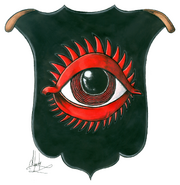
Depiction of Mordor's coat-of-arms, with the Eye of Sauron
An interesting dichotomy is set up between his deceptive nature and his symbol. While rarely appearing personally and deceiving all but the most wary, he represented himself as an all-seeing eye that could pierce all disguises.
The extent, nature, and specifics of Sauron's power are largely left to the imagination. Like Morgoth, he was capable of altering the physical substance of the world around him by mere effort of will.
Symbol
The symbol of Sauron was the Eye of Sauron, particularly after he arose in Mirkwood at Dol Guldur. In The Lord of the Rings it is called also the Great Eye, the Eye of Barad-dûr, the Red Eye, the Lidless Eye, and the Evil Eye.
Earlier versions of the legendarium
Since the earliest versions of the Silmarillion legendarium (as detailed in The History of Middle-earth), Sauron underwent many changes. The prototype of his character was Tevildo, "Prince of Cats", who played the role later taken by Sauron in the earliest version of the story of Beren and Lúthien told in The Book of Lost Tales Part Two. Tevildo was soon transformed into Thû, the Necromancer, whose name would be emended to Gorthû, Sûr, and finally to Sauron. Gorthû in the form Gorthaur remained in The Silmarillion. In Númenor, he was once known (according to The Notion Club Papers and associated writings) as Zigûr.
Prior to the publication of The Silmarillion, Sauron's origins and true identity were unclear to those without full access to J.R.R. Tolkien's notes, so that early editions of the Guide to Middle-earth described Sauron as "probably of the Eldar elves".
Appearances
In the books
- The Hobbit (Only mentioned as "the Necromancer")
- The Fellowship of the Ring
- The Two Towers
- The Return of the King
- The Silmarillion
- The Children of Húrin
- Unfinished Tales
- The History of Middle-earth
In films
- An Unexpected Journey (As the "Necromancer")
- The Desolation of Smaug (As the "Necromancer" and as himself)
- The Battle of the Five Armies
- The Fellowship of the Ring
- The Two Towers
- The Return of the King
In video games
- The Lord of the Rings: The Battle for Middle-earth
- The Lord of the Rings: The Battle for Middle-earth II
- The Lord of the Rings: The Battle for Middle-earth II: The Rise of the Witch-king
- The Lord of the Rings: Conquest
- The Lord of the Rings: The Third Age
- The Lord of the Rings: The Return of the King
- LEGO The Lord of the Rings: The Video Game
- LEGO The Hobbit: The Video Game
- Guardians of Middle-earth
- Middle-earth: Shadow of Mordor
- Middle-earth: Shadow of War
- LEGO Dimensions
Portrayal in adaptations
The Lord of the Rings film trilogy
You know of what I speak, Gandalf. A great eye, lidless, wreathed in flame.
—Saruman to Gandalf in The Fellowship of the Ring.

Sauron's primary appearance throughout the film trilogy is as a flaming eye
Sauron's primary appearance in Peter Jackson's trilogy is as the Eye of Sauron, a titanic, flaming eye atop Barad-dûr; many characters refer to it as "the Eye" or "the Great Eye." His prior physical form was as a nine-foot-tall being clad in black armor, seen only in flashbacks to the War of the Last Alliance throughout the trilogy, and very briefly in the center of the Eye in an extended scene with Aragorn and the palantír in The Return of the King. When Sauron speaks, it is telepathically through the One Ring or the Palantír; when he is voiced by Alan Howard. Sala Baker portrays his physical form.
"You cannot hide. I see you. There is no life in the void, only death."
- Sauron in The Fellowship of the Ring

Sauron is portrayed as an armoured figure in the flashbacks
As in the books, Sauron is the primary antagonist throughout the films. He is depicted as an almost god-like entity whose mere presence, even when mediated by a medium like the Palantír, causes immense pain and injury. Most of his bidding is achieved through his various servants such as the Nazgûl and Saruman, who calls him "the Lord of the Earth." Sauron is most extensively depicted in the prologue to The Fellowship of the Ring, shown forging the One Ring and leading his armies at the Battle of Dagorlad in the War of the Last Alliance. According to Tolkien's description, he is shown to be towering over men and yet not gigantic. He also wears black armor and a helmet similar to Morgoth's in The Silmarillion, and wields a giant mace (perhaps based on Grond) capable of killing scores of men in one hit.
Sauron was originally intended to appear in physical form at the climax of The Return of the King, appearing at the Battle of the Morannon to fight Aragorn. However, this was ultimately scrapped from the film due to the fact it was not in the book and the developers believed it would take the main focus away from Sam and Frodo. Furthermore, Jackson believed it would take away from Aragorn's act of sacrifice.
The Eye of Sauron's feline appearance is a reference to the character of "Tevildo" in the first drafts, who took the form of a cat.
The Hobbit film trilogy
It has begun. The East will fall. So shall the Kingdom of Angmar rise. The time of the Elves is over. The Age of the Orc has come.
—Spoken in the Black Speech, as Sauron reveals himself to Galadriel
Sauron's role from The Hobbit is greatly expanded in Jackson's Hobbit film trilogy. He is voiced by Benedict Cumberbatch.
Sauron appears in An Unexpected Journey in the form of a black, humanoid ghost, alluding to Tolkien's description of the Necromancer as a man with blackened skin. He is briefly witnessed in this form by Radagast.
In the The Desolation of Smaug, Sauron reveals a greater extent of his powers. He is first seen speaking with Azog, ordering him to break off pursuit of Thorin II Oakenshield, whose head he had promised the Orc, in order to lead his armies. When Gandalf arrives in Dol Guldur to investigate tales of an evil there, Sauron first confronts him as a mass of black smoke. After killing Thráin II and initiating a brief duel with the Grey Wizard, Sauron is able to overpower the wizard and reveals himself as an armored figure within the shape of an enormous, flaming eye.
In The Battle of the Five Armies, Galadriel, Elrond, and Saruman (the White Council) travel to Dol Goldur to free Gandalf. There, Sauron releases the Nazgûl upon them, but the Ringwraiths are defeated by the Council. It is then that Sauron appears as a spectral armored form within a flaming eye, accompanied within the fire by the Ringwraiths' ghostly forms. Sauron threatens the Council with the fall of the West and the rise of Angmar, but is engaged by Galadriel (in her spectral form) in a magical duel of minds. Though powerful, much of Sauron's former strength had yet to return and he was unable to defeat Galadriel. While the act severely weakens her, Sauron is forced to flee as a ball of fire into the East. Afterwards, Saruman promises the Council that he will handle Sauron personally, only for the Istari to forge a secret alliance with him.
The extended edition confirms Sauron has forged an alliance with Smaug, as well as showing him murdering Thrain during his battle with Gandalf.
Video games
- In The Lord of the Rings Online, Annatar was depicted in a mural in the ruins of Tham Mírdain. He was called Antheron (Gift Lord), because Turbine doesn't have the rights to the name Annatar. In the session play quest 'Daughter of Strife' from Volume I: Book XV, where the player takes on the character of Narmaleth, Sauron is also encountered in his disguise of Annatar (Antheron), at the time he taught the elves of Eregion the secrets of the Rings. Visiting Sauron's personal chambers in Dol Guldur leads to a vision of the Dark Lord, still weak and recovering from his defeat at the hanf of Isildur. During an extended flashback sequence to the War of the Last Alliance, Sauron himself is met within Barad-dur by the player, who controls a historic character.
- In the strategy game The Lord of the Rings: The Battle for Middle-earth II, Sauron is one of the Ring Heroes, the other being Galadriel, which can be summoned when a player successfully finds Gollum and take the One Ring by killing him. He can only be summoned by the evil factions Mordor, Isengard and Goblins. Sauron is one of the strongest, if not, the strongest unit in the game, as he is very hard to kill and able to instantly kill most infantry and cavalry units with his mace. More powerful units, such as Trolls and Ents are still no match for him in small amounts, being easily killed by a few blows of his mace. Sauron is also able to summon fiery rocks from the skies and demoralize enemy units, causing them to run around in panic. When Sauron is killed, he explodes violently, heavily damaging any enemy units in the vicinity. Upon his death, he drops the One Ring, which may be picked up to summon another Ring Hero.
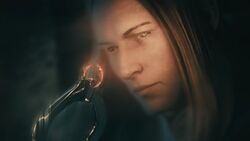
Sauron, disguised as Annatar, with the newly-forged One Ring
- In the 2014 Middle-earth: Shadow of Mordor video game, Sauron appears before Celebrimbor as Annatar, the Lord of Gifts, and deceives him into creating the Rings of Power. After the secret forging of the One Ring, Annatar takes Celebrimbor to Mordor to pefect the One Ring. Celebrimbor later escapes Mordor with the Ring and uses its power to challenge Sauron into battle. At the last moment, the Ring slips from Celebrimbor's finger. As vengeance, Sauron transforms back into Annatar and proceeds to kill Celebrimbor.
- In the 2017 sequel to the above, Middle-earth: Shadow of War, he ends up fighting Celebrimbor despite still being weakened by the loss of the One Ring. Despite putting up a good fight, he is overwhelmed by Celebrimbor and his new host Eltariel planning on dominating him with the power of their own New Ring. Before succumbing, he cuts off Eltariel's ring finger like Isildur had done to him years earlier, and consumed Celebrimbor's wraith. While he survives, this forces him into a new form; a burning eye at the top of Barad-dûr, locked in a battle of wills with the elf until the One Ring is destroyed decades later.
- Sauron appears in both LEGO The Lord of the Rings: The Video Game and LEGO The Hobbit: The Video Game; in the first he is a boss and playable character while he is featured as a playable character in the latter. His boss form appears as a massive CCBS figure-similar to something from LEGO's Knights Kingdom line, while as a playable character he appears as a minifigure. In The Hobbit game he appears in both Necromancer and fiery armored forms. The first game also features an Annatar minifigure as a downloadable character.
- Sauron's minifigure form, voiced by Steven Blum, also appears in LEGO Dimensions, where he invades DC Comics' Metropolis and later engages the player in a battle atop a Doctor Who Dalek flying saucer; upon defeat he is banished back to the domain of primary game antagonist Lord Vortech and does not appear again.
- In The Lord of the Rings: Conquest, Sauron is a playable character.
Other media
Sauron also appears or is referenced in a number of works that are not direct adaptations of The Lord of the Rings or it's associated mythos:
- Sauron of Marvel Comics adopted the name in homage to the Tolkien character.[17]
- Sauron served as the inspiration for the My Little Pony: Friendship is Magic antagonist King Sombra in his initial appearance.[18]
- In The LEGO Batman Movie, Sauron-in his flaming eye form atop his tower-is among the villains recruited by The Joker to aid in his conquest of Gotham City. His powers of vision prove quite a nuisance to Batman and his companions, but he is eventually inadvertently destroyed by the Kraken's mouth projectile. He is here voiced by actor Jemaine Clement.
Trivia
- He is one of only three characters to appear in all six films of both The Hobbit and The Lord of the Rings trilogies, the other two being Gandalf and Galadriel.
Gallery
 |
 |
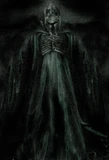 |
 |
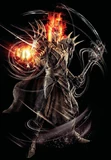 |
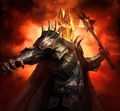 |
 |
 |
 |
 |
 |
 |
 |
 |
 |
Translations
| Foreign Language | Translated name |
| Arabic | سورون |
| Armenian | Սաւրոն |
| Belarusian Cyrillic | Саўран |
| Bengali | সৌরণ |
| Bulgarian Cyrillic | Саурон |
| Catalan | Sàuron |
| Chinese (Hong Kong) | 索倫 |
| Esperanto | Saŭrono |
| Georgian | საურონი |
| Greek | Σάουρον |
| Gujarati | સેરોન |
| Hebrew | סאורון |
| Hindi | सौरोन |
| Hungarian | Szauron |
| Japanese | サウロン |
| Kannada | ಸೌರಾನ್ |
| Kazakh | Саурон (Cyrillic) Sawron (Latin) |
| Korean | 사우론 |
| Kyrgyz Cyrillic | Саурон |
| Laotian | ສະຸrໂນ |
| Lithuanian | Sauronas |
| Macedonian Cyrillic | Саурон |
| Marathi | सायरोन |
| Mongolian Cyrillic | Саурон |
| Nepalese | षौरोन् |
| Pashto | صاورون |
| Persian | سائورون |
| Punjabi | ਸਾਨੌਨ |
| Russian | Саурон |
| Sanskrit | षौरोन् |
| Serbian | Саурон (Cyrillic) Sauron (Latin) |
| Sinhalese | සොරෝන් |
| Tajik Cyrillic | Саурон |
| Tamil | ஷௌரொந் |
| Telugu | సారన్ |
| Thai | เซารอน |
| Ukrainian Cyrillic | Саурон |
| Urdu | ہاتھوں |
| Uzbek | Саурон (Cyrillic) Sauron (Latin) |
| Yiddish | סאַוראָן |
| Bearers of the One Ring | |
|---|---|
References
- ↑ The Silmarillion, Of the Rings of Power and the Third Age
- ↑ The Silmarillion, Valaquenta, "Of the Enemies"
- ↑ 3.0 3.1 The Silmarillion, Index of Names
- ↑ The Silmarillion, Quenta Silmarillion, Chapter III: "Of the Coming of the Elves and the Captivity of Melkor"
- ↑ The Silmarillion, Quenta Silmarillion, Chapter XVII: "Of the Coming of Men into the West"
- ↑ The Silmarillion, Quenta Silmarillion, Chapter XVIII: "Of the Ruin of Beleriand and the Fall of Fingolfin"
- ↑ 7.0 7.1 The Silmarillion, Quenta Silmarillion, Chapter XIX: "Of Beren and Lúthien"
- ↑ The Silmarillion, Quenta Silmarillion, Chapter XXIV: "Of the Voyage of Eärendil and the War of Wrath"
- ↑ The Lord of the Rings, The Return of the King, Book Five, Chapter IX: "The Last Debate"
- ↑ The Lord of the Rings, The Return of the King, Book Six, Chapter III: "Mount Doom"
- ↑ The Lord of the Rings, The Return of the King, Book Six, Chapter IV: "The Field of Cormallen"
- ↑ The Silmarillion, Appendix: Elements in Quenya and Sindarin names
- ↑ Parma Eldalamberon, Words, Phrases and Passages in Various Tongues in The Lord of the Rings by J.R.R. Tolkien
- ↑ Unfinished Tales, Part Two: The Second Age, chapter IV: "The History of Galadriel and Celeborn, and of Amroth King of Lórien", Note 7
- ↑ The History of Middle-earth, Vol. 5: The Lost Road and Other Writings, Part One: "The Fall of Númenor and the Lost Road"
- ↑ The Letters of J. R. R. Tolkien, 183 Notes on W. H. Auden's review of The Return of the King
- ↑ X-Men #60 (September, 1969)
- ↑ GuyWithNoNickName (2012-12-04). Meghan McCarthy Talks About King Sombra On "Stay Brony My Friends". YouTube. Retrieved on 2012-12-06.
External link
- Sauron at LotrProject
